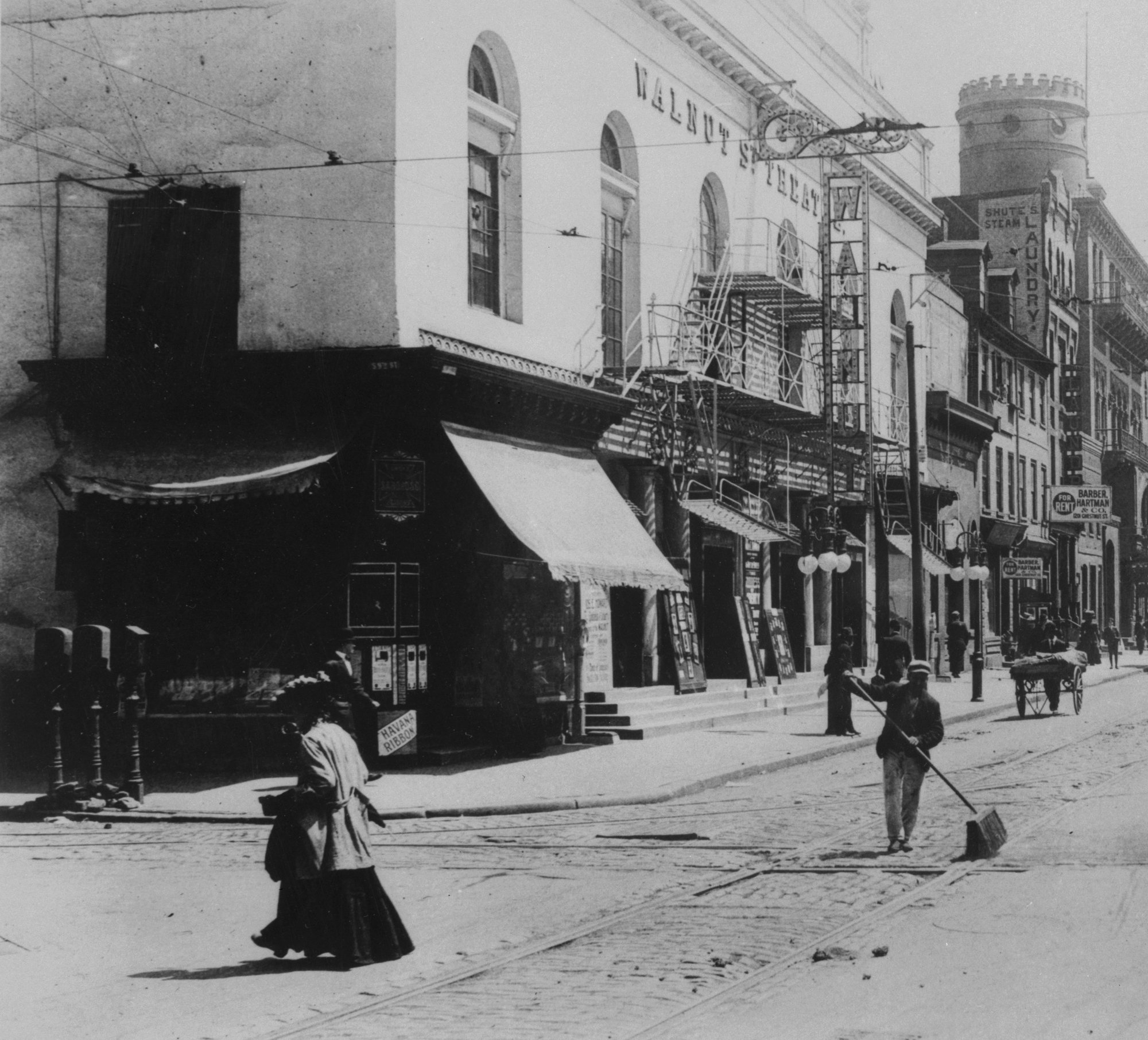
THE ORIGINAL PRODUCTION
1923 - 1925
The original I’ll Say She Is was an accidental masterpiece, the result of chance meetings and desperate measures. It was a jalopy made of recycled parts, and it was the perfect vehicle for the arrival of the Marx Brothers on Broadway.
The Marx Brothers began the 1920s with a series of failures.
Their first British tour was a disappointment. Being blacklisted from big time vaudeville in the States was an even
Broadway riffraff: Leonard, Arthur, Julius, and Herbert in the 1920s
bigger disappointment. They tried to make a silent movie, Humor Risk — that didn’t work out. They tried appearing on the experimental Shubert Advanced Vaudeville circuit — that didn’t work out either. When their old associate Ned Wayburn called them to his office to meet Tom and Will B. Johnstone, who had a deal to write a revue and needed headliners, the Brothers were in no position to demur. It turned out to be the right project at the right time. In their recent vaudeville tabs, On the Mezzanine (aka On the Balcony) and The Twentieth Century Revue, they’d been moving closer to the format of a Broadway revue, and reinventing their early vaudeville characters. Groucho had dropped the German/Yiddish accent and painted a moustache on his face. Harpo and Chico’s stock characters had developed into new and idiosyncratic comic personas. And Gummo had left the act, making room for baby brother Zeppo. The Broadway Marx Brothers were born — they just had to get to Broadway.
The dawn of a new age: The Four Marx Brothers in On the Mezzanine, 1921
The Twentieth Century Revue, Shubert Vaudeville, 1922
Will B. Johnstone was a restless creative polymath.
Today, he’s best remembered as cowriter of two of the Marx Brothers’ best films, Monkey Business and Horse Feathers. He was
Will B. Johnstone
Tom Johnstone
also a prolific political cartoonist, whose signature creation — the naked taxpayer wearing a barrel — would become one of the defining images of the twentieth century. He also wrote a number of musical comedies and revues, often in collaboration with one of his brothers, Alexander and Tom, both composers. The Johnstones wrote a number of musicals for producer Joseph “Minimum” Gaites, some of which scored modest successes on Broadway and on the road. One of their failures was Love for Sale, a revue about a society woman looking for thrills, starring Kitty Gordon. Gaites and the Johnstones repurposed much of the same material for Gimme a Thrill, also a failure. But Gaites believed in the power of the premise. When Joseph P. Beury acquired Philadelphia’s Walnut Street Theatre and invited Gaites to produce a summer revue there, Gaites asked the Johnstones to work up the society-woman-looking-for-thrills story one more time, and find a starring comedian or comedians capable of putting it over the top.
Kitty Gordon in Love for Sale, 1919
Proto-I’ll Say She Is: Gaites and the Johnstones present Gimme a Thrill, 1922-1923

“A year and a half was enough of an out-of-town try-out for any show.
EITHER I’LL SAY SHE IS WENT TO NEW YORK OR THE MARX BROTHERS TOOK A WALK.”
— HARPO MARX, Harpo Speaks
By 1923, hopes for success on Broadway represented the only chance for the Marxes’ future in showbiz. It wasn’t just the drying-up of opportunities in vaudeville; the boys were no longer boys, and they were tired. They’d been on the road since childhood, and now they were pushing forty. Groucho and Chico had children of their own. They wanted what Groucho called “a soft racket,” a job that would allow them to get off the road, stay home in New York, and casually report to a Broadway theatre for eight shows a week. Their willingness to appear in I’ll Say She Is was based specifically on assurances from Gaites and Beury that they would take the show to New York following its summer engagement at the Walnut Street Theatre in Philadelphia.
I’ll Say She Is storms Walnut Street, 1923
But plans changed. First, the show was a bigger hit in Philadelphia than anyone had dared to hope. It ran all summer, in a town that had never before supported musical comedy in warm weather. Gaites and Beury realized that The Four Marx Brothers in I’ll Say She Is could be a cash cow on the road, though they remained confident it would
die a quick death on Broadway. So they resolved to keep the show on the road as long as possible: Boston. Pittsburgh. Detroit. Chicago. Kansas City. St. Louis. Cincinnati. And on and on and on, every step of the way reassuring the Marx Brothers that New York would be their next stop, or possibly the stop after that.
Groucho and Harpo in the Napoleon Scene with Muriel Hudson, 1923
Groucho and Harpo in the Napoleon Scene with Lotta Miles, 1924
Despite the Brothers’ impatience, it was probably good for I’ll Say She Is to have this arduous road to Broadway. The major scenes, tested and tinkered with and improvised over and over in front of audiences, developed the kind of airtight certainty only achievable through exhaustive repetition. Some of the Brothers’ material was recycled from their old vaudeville repertoire. On the road, the newer stuff — including “Napoleon’s First Waterloo,” a tour
de force sketch featuring Groucho as Napoleon — sharpened into their best material yet. They also found an ideal leading lady in Lotta Miles (aka Florence Reutti), a former Kelly Tires mascot, who replaced Muriel Hudson in the role of Beauty.
By the spring of 1924, fate could no longer be denied. Beury talked the Marxes into a quick return engagement in Philadelphia, then took a deep breath and booked a May 19, 1924 opening at the Casino Theatre, Broadway and 39th Street.

“A MASTERPIECE OF KNOCK ‘EM DOWN AND DRAG ‘EM OUT HUMOR”
— GEORGE JEAN NATHAN, American Mercury
The Casino Theatre
I'll Say She Is at the Casino Theatre was a phenomenal success, lavishly praised by Algonquin Round Table tastemakers like Alexander Woollcott and Robert Benchley. The Marx Brothers became the darlings of the New York smart set and the preeminent jesters of the Jazz Age. Although there would be other, arguably greater, achievements ahead, the Marxes never felt bigger than
they did at the Casino in I’ll Say She Is. It was the arrival of the Marx Brothers as a phenomenon, a force in popular culture. As Joe Adamson puts it in Groucho, Harpo, Chico, and Sometimes Zeppo, it was “the beginning of the Marx Brothers Proper.”
The show set the tone for the rest of the Brothers' career. Will B. Johnstone remained a key collaborator, contributing to the screenplays of Monkey Business, Horse Feathers, and A Day at the Races. Every Marx Brothers film contains material and situations that can be traced back to I'll Say She Is. However, unlike
The Marx Brothers and Lotta Miles performing the Napoleon Scene on Broadway, 1924
their next two Broadway shows, The Cocoanuts and Animal Crackers, I'll Say She Is was never adapted for film, or revived onstage. It had a smash run at the Casino, closed on February 7, 1925, spent a few more months on the road, and was not seen for the next ninety years.

For a complete history of I’ll Say She Is, read Gimme a Thrill: The Story of I’ll Say She Is, the Lost Marx Brothers Musical, and How it Was Found!
Jas. P. Beury presents
the Musical Comedy Revue
I'LL SAY SHE IS!
with The Marx Brothers
Book and Lyrics by Will B. Johnstone
Music by Tom Johnstone
Book Directed by Eugene Sanger
Numbers Staged by Vaughn Godfrey
Orchestra Under the Direction of Ted Coleman
Entire Production Under the Personal Direction of Jas. P. Beury
The Cast (In Order of First Appearance)
Theatrical Agent (Richman) ….. Edward Metcalfe
Office Girl ….. Crissie Melvin
Doctor ….. Herbert Marx
Poorman ….. Leonard Marx
Lawyer ….. Julius H. Marx
Beggarman ….. Arthur Marx
Chief ….. Lloyd Garrett
Merchant ….. Phillip Darby
Thief ….. Edgar Gardiner
Social Secretary ….. Ruth Urban
Beauty ….. Carlotta Miles
Pages ….. Melvin Sisters
White Girl ….. Cecile D'Andrea
Hop Merchant ….. Harry Walters
Gold Man ….. Ledru Stiffler
Hazel ….. Hazel Gaudreau
Marcella ….. Marcella Hardie
Ladies of the Ensemble: Misses Gene Spencer, Bunny Parker, Florence Arledge, Jane Hurd, Alice McDonald, Marion Case, Gertrude Cole, Catherine Norris, Mary Carney, Helen Martin, Muriel Greel, Ethel Emery, Mildred Joy, Aileen Meehan, Jeane Green, Florence Thorpe, Vivian Spencer.
On Broadway at the Casino Theatre
May 19, 1924 - February 7, 1925
Newspaper artist Hap Hadley’s drawing of the I’ll Say She Is chorus on Broadway, 1924
Five chorus girls on stage at the Casino, on the staircase with the iconic — yes, that’s right, ICONIC! — I’ll Say She Is curve design.
The Melvin Sisters
D’Andrea and Walters in the Pygmalion and Galatea ballet
Groucho Marx and Lotta Miles in the Cinderella Backward scene
Lotta Miles. Isn’t she a beauty?



















